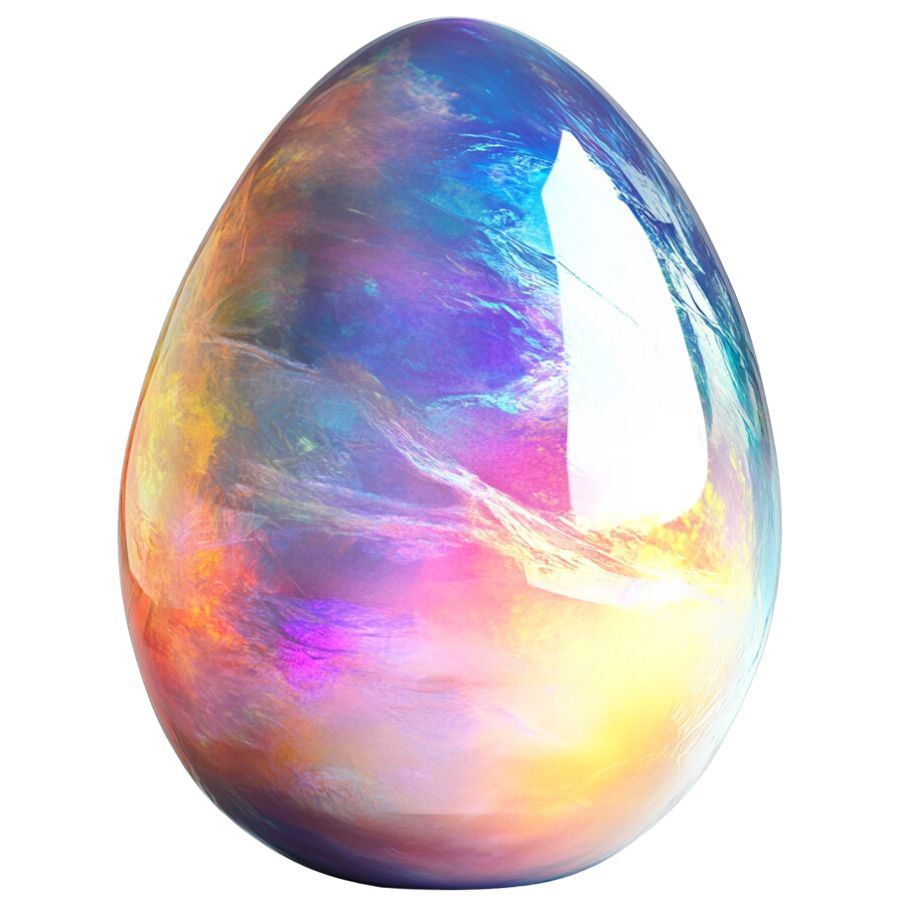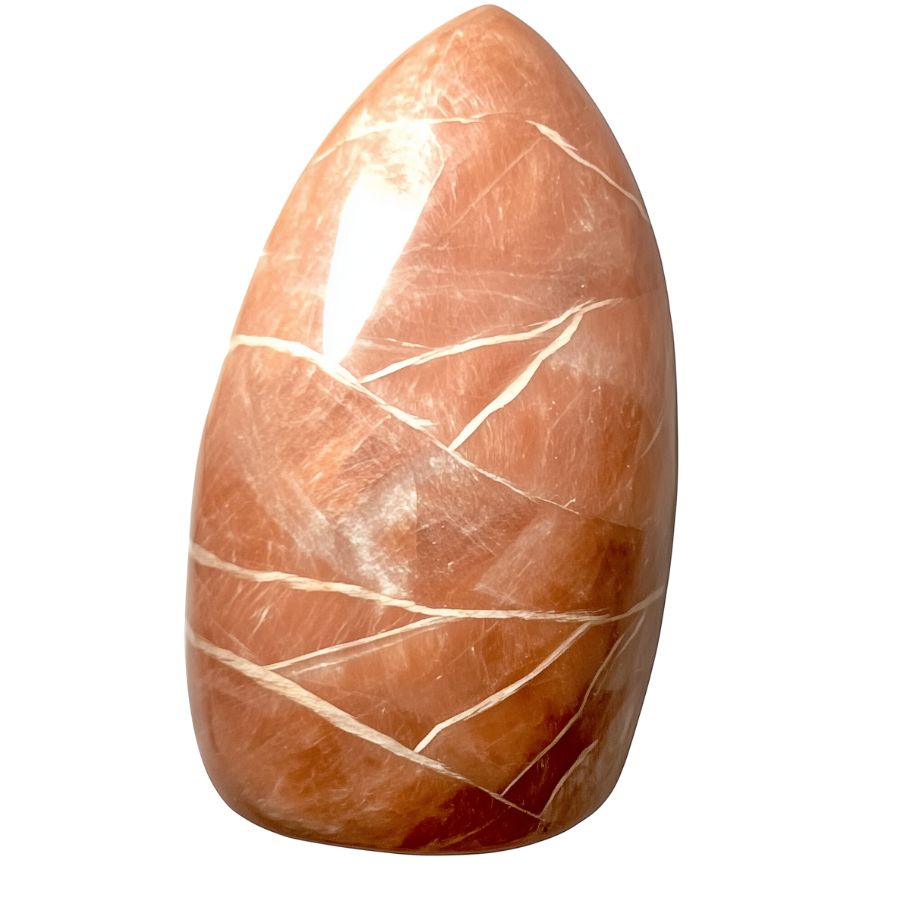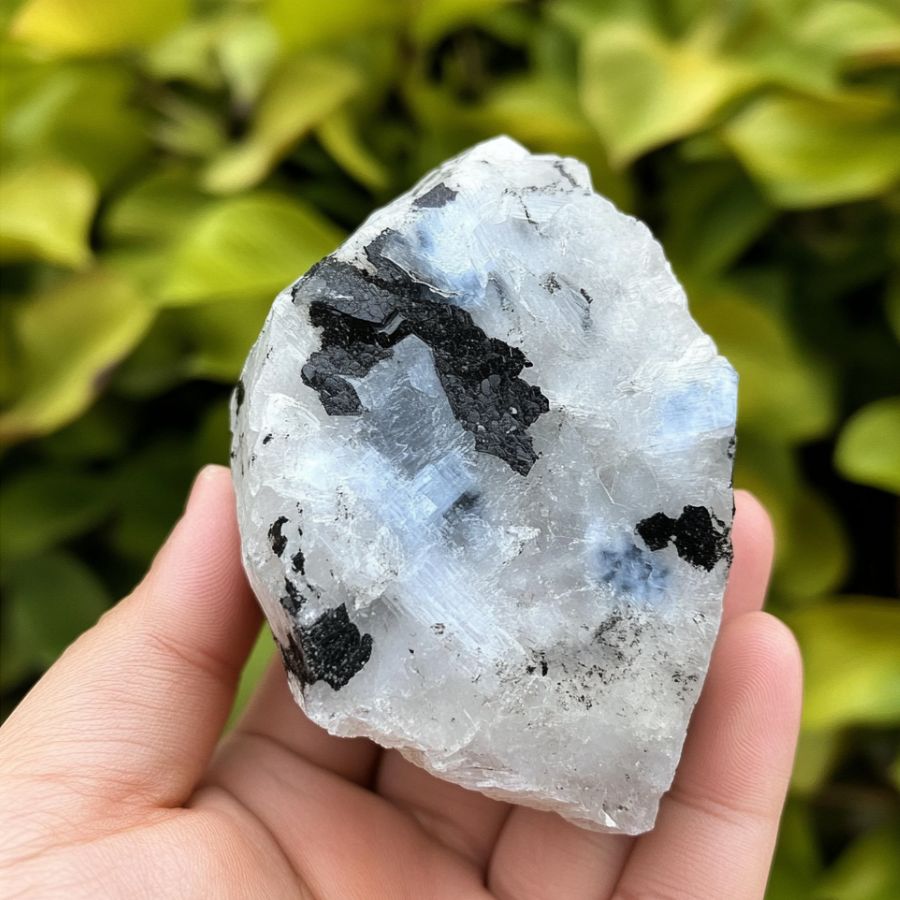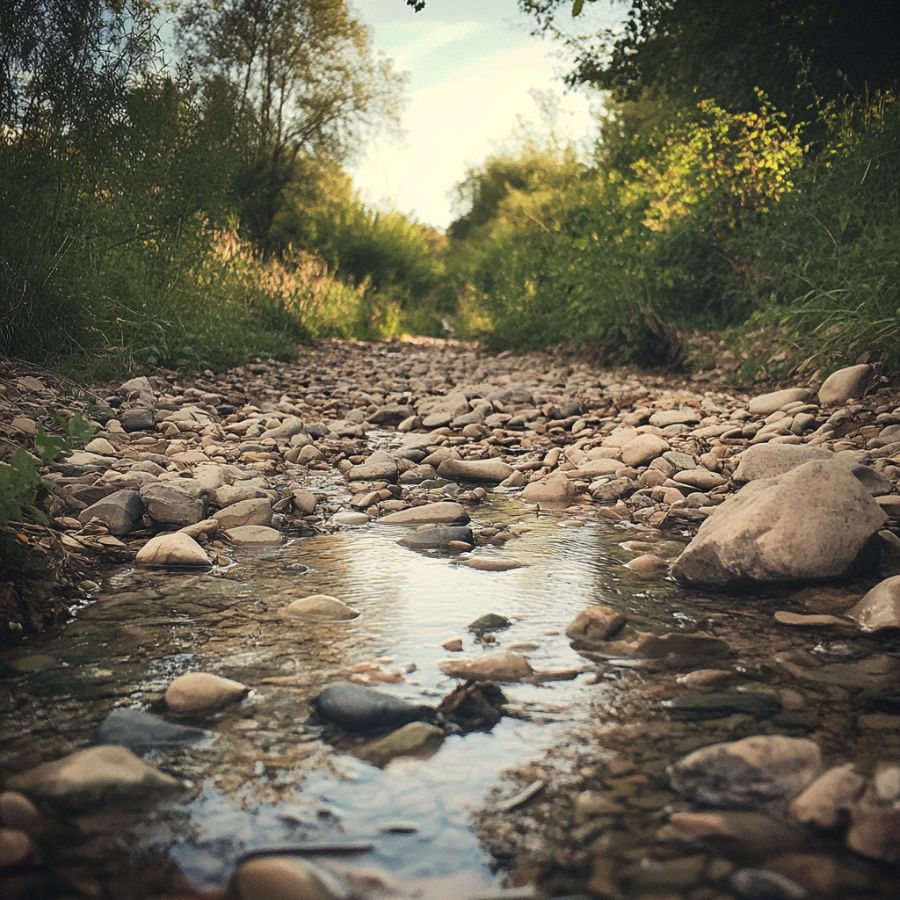From the Atlantic Ocean to the Appalachian Mountains, from Maryland’s border to North Carolina’s edge, Virginia offers a treasure trove for moonstone hunters.
However, many rockhounds struggle to find reliable locations, wasting time and energy on fruitless searches. We understand your frustration.
That’s why we’ve compiled this guide to the best moonstone spots in the Old Dominion State. Our carefully researched list will save you hours of aimless wandering and lead you straight to the most promising sites.
Whether you’re a seasoned collector or a curious beginner, this article will help you uncover Virginia’s hidden lunar gems.
How Moonstone Forms Here

Moonstone starts as feldspar, a mineral made of aluminum and silicate. As the rocks cool slowly, two types of feldspar—orthoclase and albite—separate into thin layers. As the layers solidify, they create the stone’s unique internal structure.
The stone’s color, usually milky white with a blue or peach glow, depends on the thickness of these layers and how they catch the light.
When light enters the stone, it scatters between these layers, producing a moonstone’s signature shimmering glow called adularescence. This optical effect makes it appear as if light is floating beneath the surface.
Over millions of years, plate tectonics push the moonstone deposits closer to the surface where they can be mined. The rarity and specific geology needed to create moonstones add to their mystique as one of the world’s most magical gemstones.
The Types Of Moonstone
Our state is a treasure trove of stunning moonstone varieties. These natural wonders come in various forms, each with its own unique charm and allure:
Blue Moonstone

Blue Moonstone is known for its transparent to translucent body with a floating blue sheen on the surface. This sheen, called adularescence, is caused by light reflecting off layers of minerals within the stone.
The most prized Blue Moonstones have a strong blue color and perfect clarity. This makes them stand out from other types, which might be colorless or milky.
What’s special about Blue Moonstone is its ethereal glow. The adularescence creates a soft, shimmering light beneath its surface. This unique optical effect, combined with its rarity, makes it popular among collectors and jewelry enthusiasts.
Rainbow Moonstone

Rainbow Moonstone is famous for its labradorescence, a colorful sheen that shows a spectrum of colors like blue, yellow, orange, and purple. This effect is especially striking against its white body color, giving it a radiant appearance.
Unlike traditional moonstones, Rainbow Moonstones’ play of colors is more vivid and varied. It’s often confused with labradorite but can be distinguished by its pearly sheen and more transparent body.
Some Rainbow Moonstones contain inclusions of black tourmaline, visible in untreated stones. This gemstone gained popularity during the Art Nouveau period and continues to be favored in modern jewelry for its unique optical effects.
Pink Moonstone

Pink Moonstone shows a delicate pink or peach hue, ranging from honey to beige. Its color is soft and subtle, setting it apart from other moonstones with more vibrant shades.
This stone has a pearly or vitreous luster and is generally translucent. High-quality Pink Moonstones often display a white sheen on the surface. Some specimens can even show a cat’s eye or star effect due to their unique internal structure.
Pink Moonstone is one of the rarest varieties of moonstone. Its delicate color and unique optical effects make it highly sought after. Unlike Pink Opal, which is more opaque, Pink Moonstone is characterized by its iridescent sheen.
Star Moonstone

Star Moonstone shows a unique optical effect called asterism, creating a four-pointed star pattern on its surface. This happens because of needle-like inclusions in the stone that reflect light in a special way.
These moonstones are usually translucent to opaque, with colors ranging from colorless to shades of blue, gray, or white. The star effect is best seen when the stone is cut into a cabochon shape.
Star Moonstone is rarer than other types, making it highly desirable. The strongest and most well-defined stars are often found in specimens from Sri Lanka.
Peach Moonstone

Peach Moonstone stands out with its soft peach or orange hue, ranging from pale to more intense shades. It has a shimmering effect called adularescence, which creates a glowing appearance under certain light.
Unlike other moonstones, Peach Moonstone’s glow is more subdued and warm-toned. It’s generally translucent to semi-transparent, allowing light to pass through and enhance its beauty.
What’s special about Peach Moonstone is its rarity. This scarcity makes it desirable among collectors and jewelry makers.
Its warm tones are particularly favored in designs aiming for a soft, romantic look. The unique color and rarity of Peach Moonstone set it apart in the world of gemstones.
Brown Moonstone

Brown Moonstone has a warm, earthy color that ranges from light honey to deep chocolate brown. It’s translucent to opaque and shows the typical moonstone glow, caused by light scattering between layers of different minerals inside the stone.
What makes Brown Moonstone unique is its rarity compared to other colors like white, gray, and rainbow. The brown color comes from iron impurities in the stone.
Brown Moonstone doesn’t show a strong play of color or iridescence like other moonstones. Its subtle beauty lies in its rich, earthy tones and soft glow. This makes it a distinctive choice for those who appreciate understated elegance in their stones.
Cat’s Eye Moonstone

Cat’s Eye Moonstone is known for its striking appearance. It has a translucent body with a narrow band of light that moves across the surface, looking like a cat’s eye. This effect, called chatoyancy, is caused by tiny needle-like inclusions in the stone.
What sets it apart from other moonstones is this cat’s eye effect. While other moonstones might have a blue sheen, Cat’s Eye Moonstone is all about this moving line of light.
The chatoyancy in Cat’s Eye Moonstone is highly sought after. It’s more valuable than standard moonstones because of how rare it is to find high-quality pieces with strong chatoyancy. This unique look makes it a favorite among collectors and stone enthusiasts.
Green Moonstone

Green moonstone captivates with its soft, pastel green hue and subtle white sheen. Unlike other moonstones, it often displays a velvety texture that’s pleasing to both eye and touch.
Each green moonstone is unique, with color variations ranging from faint green streaks to more pronounced green hues within a milky white base. This diversity means no two stones look exactly alike.
The stone’s green color comes from its high nickel content, making it a rarer find in the moonstone family. This unique composition sets it apart and makes it a favorite among collectors who appreciate its distinctive appearance.
What Rough Moonstone Looks Like
It’s important to understand what a rough moonstone looks like to know what you’re looking for. Here are a few things to keep an eye for:
Check for a Glassy or Waxy Luster

Look for a shiny surface. Moonstone usually has a glassy or waxy luster. It might not sparkle like a diamond, but it has a soft glow.
Hold it up to the light and see if it catches a gentle sheen. If you spot that smooth, silky look, you might have found one.
DON'T MISS OUT ON ANY GREAT FINDS!
While you're out searching for Moonstone you're going to find a lot of other interesting rocks and minerals along the way. The last thing you want to do is toss out something really interesting or valuable. It can be easy to misidentify things without a little guidance.
We've put together a fantastic field guide that makes identifying 140 of the most interesting and valuable rocks and minerals you will find REALLY EASY. It's simple to use, really durable, and will allow you to identify just about any rock and mineral you come across. Make sure you bring it along on your hunt!
Assess the Density and Weight

Moonstone feels relatively light for a gemstone. If you pick it up and it feels heavier than expected, it might not be moonstone.
The specific gravity ranges from 2.54 to 2.66, so it should feel somewhat light in your hand.
Notice the Blue or White Sheen

Tilt the stone in your hand. If you notice a blue or white sheen, that’s a good sign. Moonstone has something called adularescence. This is when light reflects inside the stone, creating a soft glow.
It’s one of the key features of moonstone, so keep an eye out for that flash of color.
Look for Rounded Edges

Notice the edges. Moonstone tends to have rounded edges, not sharp ones. This is due to the way it forms in nature.
The rounded shape makes it easier to spot when you’re searching. Keep an eye out for stones with soft, curved edges.
A Quick Request About Collecting
Always Confirm Access and Collection Rules!
Before heading out to any of the locations on our list you need to confirm access requirements and collection rules for both public and private locations directly with the location. We haven’t personally verified every location and the access requirements and collection rules often change without notice.
Many of the locations we mention will not allow collecting but are still great places for those who love to find beautiful rocks and minerals in the wild without keeping them. We also can’t guarantee you will find anything in these locations since they are constantly changing.
Always get updated information directly from the source ahead of time to ensure responsible rockhounding. If you want even more current options it’s always a good idea to contact local rock and mineral clubs and groups
Tips on Where to Look
When you reach the places we’ve listed below, keep these things in mind while searching:
Riverbeds and Streams

Check out riverbeds and streams. Moonstones can often be found in these areas.
They wash down from the mountains and settle in the gravel. Search along the edges, especially after heavy rain. It’s an easy way to start.
Sandy Beaches

Head to sandy beaches. Look where the sand meets rocks or pebbles. The constant movement of the water helps uncover hidden treasures.
You might find moonstones mixed in with other small stones. The search here can be fun and rewarding.
Old Quarries

Visit old quarries. These places often have piles of loose rocks and gravel where moonstones might be hiding.
The digging and blasting might have already brought them to the surface. Just a little effort and you might find something cool.
Sedimentary Rocks

Check sedimentary rock areas. Moonstones form in these rocks, so they’re likely to be around.
Look for outcroppings or places where the rocks have broken apart. The stones might be easier to spot after some weathering.
The types of Moonstone can you find around the state
Virginia is home to two notable types of moonstone: green moonstone and pink moonstone.
Green Moonstone is characterized by its vibrant green hue, which can vary from light to deep shades. The presence of iron in its composition contributes to its green coloration, making it a popular choice for jewelry and decorative pieces.
Pink Moonstone, on the other hand, showcases delicate pink tones that can range from soft pastels to more pronounced shades. Like its green counterpart, pink moonstone also displays adularescence, enhancing its appeal.
Both types are cherished not only for their aesthetic qualities but also for their metaphysical properties, believed to promote peace and harmony.
Some Great Places To Start
Here are some of the better places to start looking for moonstones in Virginia:
Always Confirm Access and Collection Rules!
Before heading out to any of the locations on our list you need to confirm access requirements and collection rules for both public and private locations directly with the location. We haven’t personally verified every location and the access requirements and collection rules often change without notice.
Many of the locations we mention will not allow collecting but are still great places for those who love to find beautiful rocks and minerals in the wild without keeping them. We also can’t guarantee you will find anything in these locations since they are constantly changing.
Always get updated information directly from the source ahead of time to ensure responsible rockhounding. If you want even more current options it’s always a good idea to contact local rock and mineral clubs and groups
Irish Creek

Irish Creek is situated near the hamlet of Montebello in Nelson County. It is located in the southern part of Virginia, nestled within the Blue Ridge Mountains.
This scenic area, known for its rich geological diversity, has yielded moonstone finds that excite gem enthusiasts. The creek’s ancient rocks tell a story of volcanic activity and metamorphosis over millions of years.
Within Irish Creek, moonstones can typically be found in areas where there are exposed rock formations and along stream beds.
The movement of water over time helps to reveal and transport these stones, making creek beds and nearby rocky outcrops ideal places to search.
Interestingly, Irish Creek was once home to a manganese mine, adding to its geological significance. The old mine site, while no longer active, serves as a reminder of the area’s mineral-rich history.
Otter Hill

Otter Hill is located in the Moneta-Forest region of Bedford County. This mountainous area boasts unique geological formations that make it a rockhounding hotspot.
The diverse rock types and mineral deposits here create perfect conditions for moonstone formation.
Explorers can find these ethereal gems along exposed rock formations and eroded hillsides. The base of Otter Hill and nearby streams are particularly promising spots. As you search, keep an eye out for the stone’s distinctive blue sheen.
Otter Hill’s rich geological history adds to its allure. The area’s varied terrain, shaped by ancient geological activity, offers a treasure trove of minerals beyond moonstone. This diversity makes each expedition an exciting adventure.
Little River

Little River is located near Manakin village and flows through the central part of the state. It’s part of the Middle James-Willis watershed, known for its diverse geological formations.
The river’s banks are a treasure trove of minerals. Years of water flow have exposed layers of sedimentary rocks, creating perfect conditions for moonstone formation. Quartz deposits in the area often hint at moonstone presence nearby.
To find moonstone, focus on the riverbanks and exposed rock layers. Sift through river sediments or explore eroded areas along the water’s edge.
The best spots are often where the river bends, as these areas tend to accumulate more minerals over time.
Goochland County itself has a rich history of gold mining, dating back to the 1800s. While searching for moonstone, you might stumble upon traces of this golden past, adding an extra layer of excitement to your rockhounding adventure.
Captain Tim Prospect

Captain Tim Prospect, located in the Amelia Court House area, is a hidden gem for rockhounds. This site, known for its mica development, also yields moonstone treasures.
The area’s geological makeup features remarkable pegmatite formations, and large igneous rocks packed with minerals. These pegmatites, formed by slow-cooling magma, create the perfect environment for moonstone crystals to develop.
When searching for moonstones at Captain Tim Prospect, focus on the weathered or fractured areas of the pegmatite veins. These spots often reveal the prized gemstones.
The site’s rich mineral diversity doesn’t stop at moonstone; it’s also famous for other minerals like amazonite and garnet.
Amelia County itself has a storied history in the mineral world. It once hosted the Morefield Mine, renowned for its rare minerals. This legacy makes Captain Tim Prospect not just a rockhounding site, but a piece of Virginia’s geological heritage.
Panther Creek

Panther Creek is a scenic area located near Buena Vista in Rockbridge County. It is situated in the southern part of the state, nestled within the Blue Ridge Mountains.
The creek’s geological makeup, shaped by ancient tectonic activity, creates an ideal environment for uncovering moonstones.
As you explore, focus on the creek bed and banks. The rushing waters have done much of the work, exposing and smoothing these lustrous stones.
The area around Panther Falls is particularly promising. Here, the water’s erosive power has carved out pools and rocky outcrops, creating natural collection points for minerals.
What makes Panther Creek special is its diversity. While searching for moonstones, you might stumble upon other interesting minerals. The creek’s rich mineral deposits are a testament to the area’s complex geological history.
Remember to check the gravel bars and sandy areas after rainfall. These spots often reveal freshly uncovered treasures, making your moonstone hunt even more exciting.
Places Moonstone has been found by county
After discussing our top picks, we wanted to discuss the other places on our list. Below is a list of the additional locations where we have succeeded, along with a breakdown of each place by county.
| County | Location |
| Amelia | H.T. Flippen Mica-Beryl Prospect |
| Amelia | Trueheart Prospect |
| Amelia | Mundane Prospect in Denaro area |
| Amelia | Maria Mine |
| Amelia | Rutherford Mines |
| Amelia | Morefield Mine |
| Goochland | Harris Mica Mine Farm |
| Hanover | Harris Mine |
| Hanover | Ashland Mill area mines, stream gravels and fields |


